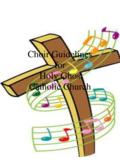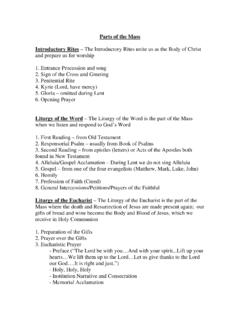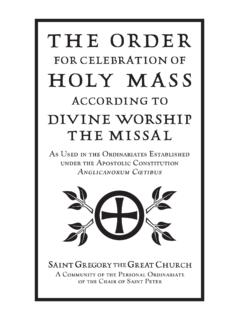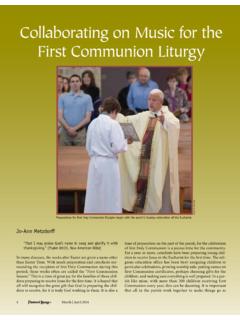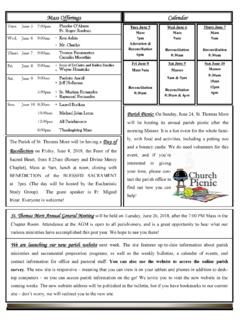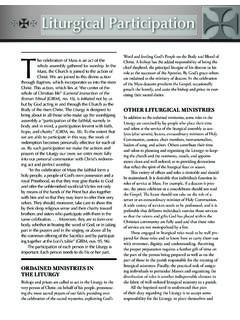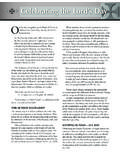Transcription of The Gospel and the Catholic Church: Anglican …
1 The Gospel and the Catholic Church: Anglican Patrimony Today / Oxford / 25 April 2018 Anglican Patrimony: A Perspective from the Holy See Archbishop J. Augustine Di Noia, OP Congregation for the Doctrine of the Faith _____ I had my first experience of the Anglican communion, when, roaming New York City s theater district as a high school student one day, I came upon the Church of St. Mary the Virgin on West 46th Street. Eventually, I would learn that this was not a Roman Catholic church, as I had assumed, but an Episcopal church founded by Father Thomas McKee Brown in 1868. He wanted to build a church in New York City dedicated to expressing the fullness of Catholic ritual and teaching within the Episcopal Church. With the support of the Episcopal Bishop of New York, Horatio Potter, and the donation of three lots by John Jacob Astor (who stipulated that the Church should be free, and positively orthodox in management and working ), Brown saw the church erected, and then dedicated on the feast of the Immaculate Conception, December 8, 1870.
2 The congregation had outgrown the church by 1890, and the present church was built on West 46th Street and dedicated in 1894. That day many years ago when I came upon what is known affectionately as Smoky Mary s because of the abundance of incense used during its solemn liturgies, that is the day that I fell in love with Anglicanism. Perhaps more importantly, that experience and many others subsequently inspired and sustained a lifelong quest to understand what, since Pope Paul VI, we have come to call the Anglican patrimony. Today, I have been asked to approach the matter from the perspective of the Holy See as it has evolved over that past ten years. It was during that period that the question about what constitutes the Anglican patrimony took on an exceedingly concrete aspect for the universal Church. Allow me to explain the nature of the new situation in which this question is now posed concretely for the universal Church by considering the development of the liturgical provisions for use by the Personal Ordinariates erected following the publication of the Apostolic Constitution Anglicanorum coetibus (2009).
3 Liturgical provisions for the personal ordinariates In 2011 the Congregation for the Doctrine of the Faith and the Congregation for Divine worship established the Anglicanae traditiones Interdicasterial Commission to undertake the task of developing liturgical provisions for use in the personal ordinarates. As a result of this work, the commission was able to authorize 2 a Lectionary for the ordinariates based on the Revised Standard Version of the Bible (Second Catholic Edition), and to produce two liturgical books. The first, which was published in April 2014, was Divine worship : Occasional Services containing the approved rites for Baptism, Holy Matrimony, and Funerals for the Personal Ordinariates. The second, Divine worship : The Missal, was published in 2015. In providing a structure for groups of Anglicans entering into full communion with the Catholic Church, the Apostolic Constitution Anglicanorum coetibus affirmed the following principle about the liturgical heritage of these groups: Without excluding liturgical celebrations according to the Roman Rite, the Ordinariate has the faculty to celebrate the Holy Eucharist and the other Sacraments, the Liturgy of the Hours and other liturgical celebrations according to the liturgical books proper to the Anglican tradition, which have been approved by the Holy See, so as to maintain the liturgical, spiritual and pastoral traditions of the Anglican Communion within the Catholic Church, as a precious gift nourishing the faith of the members of the Ordinariate and as a treasure to be shared (Art.)
4 III). With the inclusion of such a liturgical provision in Anglicanorum coetibus, the Holy See acknowledged the legitimate patrimony of Anglican ecclesial communities coming into full communion. The presumption here is that an essential part of that patrimony must be liturgical since worship expresses in a most tangible way not only the ethos of a community, but also the faith that prompted it to seek full communion in the first place. Just as it would be unthinkable to describe the Catholic Church without reference to its liturgical and sacramental life, so it would in some sense be for every ecclesial body. The manner in which an ecclesial community worships uniquely expresses its inner life. (A session of our conference will consider this aspect of the Anglican tradition this afternoon.) The publication of Divine worship was of historic significance in that this is the first time the Catholic Church acknowledged the value of liturgical forms in use in communities that emerged in the sixteenth century reformations and, moreover, undertaken to incorporate them.
5 To be sure, the Church over the years has drawn elements of the musical traditions of these communities such as hymns, motets, and chorales but never official liturgical texts or usage. In order to understand the context and orientation for these liturgical provisions as they bear on our topic in this conference, several elements merit attention here. First among these is the pastoral motivation for undertaking the project in the first place. Then, by examining the notion of English Catholic or Anglican patrimony, we can better grasp the significance of its incorporation into Catholic worship for both the Church herself and for the Anglican patrimony as such. 3 The pastoral project of Divine worship Naturally, practical concerns in part prompted the establishment of the joint commission. As we have seen, because the Apostolic Constitution Anglicanorum coetibus granted the ordinariates the faculty of celebrating the sacred liturgy according to the liturgical books proper to the Anglican tradition, it became necessary to detail concretely how those celebrations would be structured and the necessary texts composed.
6 But this practical motivation should not distract from the broader pastoral motivation: the salvation of souls though access to sacramental grace. This pastoral concern informed the English liturgical patrimony from its earliest beginnings. Many of you are acquainted with the famous exchange between Pope St. Gregory the Great and St. Augustine of Canterbury (as recorded by St. Bede) regarding the structure and content of liturgical worship in newly-evangelized England. It is an exchange which loses none of its relevance in the present day and can be said to have provided the theological structure, if not the very charter, of the joint commission s work. According to Venerable Bede, Augustine's question was: Since we hold the same Faith, why do customs vary in different Churches? Why, for instance, does the method of saying Mass differ in the holy Roman Church and in the Churches of Gaul?
7 Pope Gregory s response went as follows: My brother, you are familiar with the usage of the Roman Church, in which you were brought up. But if you have found customs, whether in the Roman, Gallican, or any other Churches that may be more acceptable to God, I wish you to make a careful selection of them, and teach the Church of the English, which is still young in the Faith, whatever you can profitably learn from the various Churches. For things should not be loved for the sake of places, but places for the sake of good things. [Non enim pro locis res, sed pro bonis rebus loca amanda sunt.] Therefore select from each of the Churches whatever things are devout, religious, and right [quae pia, quae religiosa, quae recta]; and when you have arranged them into a unified rite, let the minds of the English grow accustomed to it (Bede, Ecclesiastical History of the English People, I, 27).
8 For things should not be loved for the sake of places, but places for the sake of good things. One can think that St. Gregory plays with the word for "places" here, meaning not only geographical places, but textual "places," or diverse formulae and traditions of worship . Such liturgical "inculturation" is only good if it nurtures faith and results in something devout, religious, and right, something unified and unifying that people can grow into. 4 This pastoral concern is the overarching context in which the inclusion of Anglican liturgical patrimony into Catholic worship should be seen. Divine worship is not a museum piece, but rather the Holy See s judicious grafting of proven Anglican shoots on the living trunk of the Roman Rite to promote new and healthier growth. In effect, following St. Gregory, Anglican patrimony is not so much worth preserving in itself. Rather, its value and virtue is measured to the degree that it positively contributes to making better Catholics and more Catholics by fanning the flames of faith, hope, and charity.
9 The identification and incorporation of the English liturgical Patrimony The recognition that there is a unique English tradition worthy of preservation was affirmed by Blessed Paul VI in 1970 when he canonized the forty English and Welsh martyrs. On that occasion he praised the legitimate prestige and worthy patrimony of piety and usage proper to the Anglican Communion (Homily 25 October 1970). In saying this, Blessed Paul VI in effect declared that notwithstanding the separation of Anglicans and Catholics since the 15th century, the English Catholic tradition preserved in Anglican Patrimony has nourished the Christian faithful in that Communion and so has enriched the Church. Cardinal Joseph Ratzinger, later Pope Benedict XVI, clearly shared this conviction. Well before he signed the Apostolic Constitution Anglicanorum coetibus into law, the then-Prefect of the Congregation for the Doctrine of the Faith had written: Much of Catholicism remained in Anglicanism, as a matter of the one hand, England separated itself from Rome, distanced itself very resolutely from [O]n the other hand, there is a firm adherence to the Catholic tradition.
10 In Anglicanism there have always been vital currents that have strengthened the Catholic inheritance (Salt of the Earth, 145). According to Cardinal Ratzinger, this Catholic inheritance or potency in Anglicanism has not only been preserved, but has also been strengthened as the rule of faith that more or less consistently informed the Prayer Book tradition. It is only in relatively recent times that the traditional Prayer Book has faded in favor of more contemporary forms of worship . In this way, the transformative power of the lex orandi embodied by the Prayer Book was diluted in practice as each local community seeks to design its worship to express its own theological and ecclesiastical outlook. It is remarkable that the Catholic Church should have undertaken a formal process such as the Anglcianae traditiones Commission to identify and incorporate the richness of Anglican liturgical practice.
